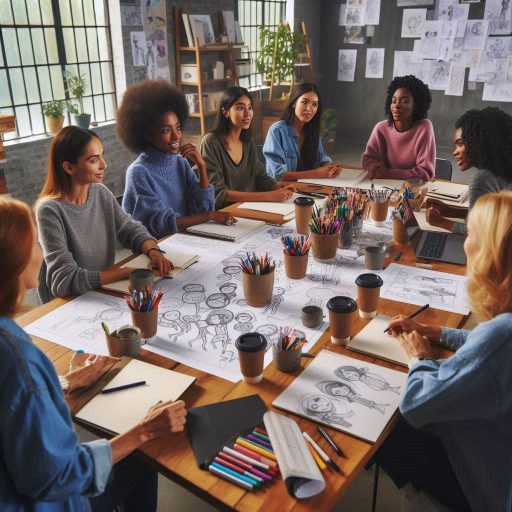Introduction
Typography is the art of arranging text in a visually appealing and readable manner.
It encompasses the selection of fonts, sizes, spacing, and layouts to effectively convey messages.
This essential aspect of design impacts how audiences interpret and engage with content.
Good typography enhances clarity by guiding the viewer’s eye and establishing a clear hierarchy of information.
Incorporating typography into design not only fosters creativity but also opens new avenues for innovation.
Unique font choices and clever arrangements can transform ordinary content into captivating visuals that resonate with viewers.
Typography can set the tone for a message, evoking specific emotions and creating a memorable experience for the audience.
It also plays a vital role in brand identity, helping to create a distinctive look that reinforces a brand’s values and personality.
In today’s digital landscape, inspiring typography projects can spark new ideas and motivate designers.
By following these projects, designers can explore fresh perspectives and innovative techniques, broadening their understanding of typography’s potential.
They can learn how typography can evoke emotions, establish connections, and enhance overall design effectiveness.
Showcase of Typography Projects
Highlighting Different Typography Projects from Various Artists and Designers
Typography continues to inspire creativity in artists and designers around the world.
Many unique projects showcase innovative approaches to type design.
Following these projects can spark your creativity and broaden your understanding of typography.
One notable project is ‘Type is Beautiful‘ by artist Jessica Hische.
In this series, Hische combines hand-lettering and digital design.
She explores the beauty of type through intricate illustrations and unique lettering styles.
Each piece highlights the personality and character of various fonts.
Another exciting project is ‘Typographic Portraits‘ by designer Hannah Davis.
In this project, Davis creates stunning portraits using only typography.
She skillfully arranges letters to form the likeness of famous figures.
This innovative approach emphasizes how type can convey emotion and identity.
‘The Typography of the Universe‘ is a project by Ben Wright.
Wright explores the universe’s complexity through typographic representations.
Each letter and number reflects astronomical elements and phenomena.
This project challenges traditional notions of typography and its boundaries.
Examples of Innovative and Inspiring Typography Designs
One inspiring design is the ‘Type Face‘ project by Natalie Kahn.
Kahn combines photography and typography to create captivating visual narratives.
Her work showcases how type can interact with images, enhancing storytelling.
This project encourages designers to think outside the box and experiment with different mediums.
‘The Alphabet Project‘ by Chris Biron is another noteworthy example.
Biron challenges himself to create a new letterform each day.
His commitment to daily practice showcases the importance of consistency in design.
Each letter reflects Biron’s unique style and perspective on typography.
‘Letterpress Love‘ is a project by Megan O‘Connell that celebrates traditional printing techniques.
O‘Connell uses letterpress to create beautiful cards and prints.
This project pays homage to the tactile nature of typography and its history.
It serves as a reminder of the craftsmanship behind printed type.
In the realm of digital typography, ‘Kinetic Typography‘ has gained popularity.
Designers like Zach Lieberman create animated text that moves with rhythm and emotion.
This project showcases how typography can transcend static design and become dynamic.
Kinetic typography captures viewers‘ attention and enhances the overall experience.
‘Typographic Mapping‘ by Diana Weymar reimagines geographical locations through type.
Weymar creates detailed maps using letters and words that represent each area.
This project combines cartography and typography, revealing new perspectives on familiar places.
Read: Visual Merchandising: Best Practices for Beginners
Behind the Scenes
Typography projects are a beautiful blend of art and design, where text is transformed into visually appealing works of art.
The creative process behind these projects is often intricate and fascinating to explore.
Let’s take a closer look at what goes on behind the scenes of inspiring typography projects.
The Creative Process
Typography projects typically start with a concept or idea that the designer wants to communicate through text.
This could be a quote, a message, or a theme that sets the tone for the overall design.
The next step involves choosing the right fonts and typefaces that will best convey the message.
Once the fonts are selected, designers work on arranging the text in a visually pleasing manner.
This includes experimenting with different layouts, sizes, and colors to create a harmonious composition.
The overall goal is to make the typography both readable and impactful.
Designers also pay close attention to spacing and alignment, ensuring that each letter and word is perfectly placed within the design.
This meticulous attention to detail helps create a polished look that draws the viewer in and keeps them engaged with the piece.
Tools and Techniques
Creating stunning typography designs requires a range of tools and techniques to bring the vision to life.
One essential tool is design software, such as Adobe Illustrator or Photoshop, which allows designers to manipulate text and create intricate compositions.
Typography projects often involve hand-lettering, where designers create custom letterforms by hand.
This adds a unique and personal touch to the design, showcasing the skill and creativity of the designer.
Additionally, designers may use techniques such as letterpress or screen printing to add texture and depth to their typography designs.
Color theory plays a crucial role in typography design, as colors can evoke specific emotions and enhance the overall message.
Designers carefully select color palettes that complement the text and create visual interest.
They also experiment with gradients, shadows, and other effects to add depth and dimension to the typography.
Typography projects are not just about creating visually appealing text but also about conveying a message or story through design.
By exploring the creative process and the tools and techniques used in typography projects.
We can gain a deeper appreciation for the art and skill behind these inspiring works of art.
Read: Visual Merchandiser: Job Market and Opportunities
Typography Trends
Current Typography Trends in Design
One prominent trend is the use of bold, oversized typefaces.
This approach captures attention and creates visual impact.
Designers often combine bold typography with minimalist layouts.
This contrast allows the text to stand out and enhance the overall design.
Another emerging trend is variable typography, where fonts can change weight, width, or style dynamically.
This versatility allows for greater creativity and adaptability in design.
Handwritten and custom typography are also gaining popularity.
These unique fonts convey authenticity and a personal touch.
Designers use them to create memorable brand identities.
Additionally, animated typography is making waves in digital design.
Motion graphics add life to text, creating dynamic user experiences.
This trend engages viewers and encourages interaction.
Gradients and vibrant colors are increasingly present in typography.
Designers are using these techniques to evoke emotions and create visually striking compositions.
Mixing different font styles and sizes within a single piece adds visual interest.
This trend breaks traditional design rules, creating a more playful and dynamic aesthetic.
How Designers Are Pushing the Boundaries of Typography
Designers are continually experimenting with new materials and technologies.
For instance, augmented reality (AR) allows typography to come alive in interactive ways.
Brands are using AR to create immersive experiences that engage users.
This innovation encourages designers to think beyond traditional typography.
Moreover, typography is transcending two-dimensional design.
Designers are integrating typography into three-dimensional spaces.
This approach allows text to become a physical part of the environment.
Examples include installations and sculptures that feature large, expressive letters.
Such projects invite viewers to interact with typography in new and exciting ways.
The use of data-driven design is another way designers are pushing boundaries.
They are creating typography based on user data and interactions.
This customization allows for personalized experiences that resonate with individual users.
Designers are also exploring generative typography, where algorithms create unique typographic layouts.
This approach challenges traditional design processes and encourages creativity.
In addition to these trends, sustainability in typography is gaining traction.
Designers are increasingly focusing on eco-friendly practices in their projects.
This shift includes using sustainable materials and promoting awareness through design.
Typography projects that highlight social and environmental issues inspire positive change.
Read: Essential Skills for Aspiring Costume Designers

Interviews with Typography Artists
One of the best ways to get inspired in the world of typography is by learning from the masters themselves.
It’s one thing to admire a finished piece of work, but it’s a whole other experience to hear about the process behind it.
That’s why interviews with typography artists are so valuable – they offer a glimpse into the mind of the creator, their inspirations, challenges, and successes.
One way to dive deeper into the world of typography is by reading feature interviews with prominent typography artists.
These interviews often reveal the personal stories and experiences that have shaped these artists’ careers.
By gaining insights into their inspiration and process, readers can learn valuable lessons that can help them improve their own craft.
Feature interviews with prominent typography artists
Typography artists often draw inspiration from a wide variety of sources, ranging from nature and architecture to music and literature.
By reading interviews with these artists, readers can get a behind-the-scenes look at how they find inspiration and turn it into stunning typography designs.
This can spark new ideas and creativity in aspiring artists, helping them think outside the box and push the boundaries of what is possible.
Transform Your Career Today
Unlock a personalized career strategy that drives real results. Get tailored advice and a roadmap designed just for you.
Start NowGain insights into their process
Typography is a complex art form that requires both technical skill and creative vision.
By learning about the process of prominent typography artists, readers can gain valuable insights into how to approach their own projects.
From brainstorming and sketching to refining and finalizing a design, understanding the steps involved in creating typography can help aspiring artists develop their own process and style.
Ultimately, interviews with typography artists are a valuable resource for anyone looking to enhance their skills and creativity in the world of design.
By gaining insights into the inspiration and process of prominent artists, readers can learn valuable lessons that can help them improve their own work.
So, whether you’re a seasoned professional or just starting out, make sure to follow interviews with typography artists to stay inspired and informed.
Read: Networking Events for Costume Designers
Typography Challenges
Common Challenges Faced by Designers When Working with Typography
Typography is a powerful tool in design, but it comes with challenges.
Designers often struggle with selecting the right typeface for their projects.
The vast array of fonts can be overwhelming, making it difficult to choose one that fits the message.
Additionally, designers must consider the readability of the chosen typeface.
Poor readability can hinder user experience and cause frustration.
Another challenge lies in balancing typography with other design elements.
Designers must ensure that the text complements images, colors, and layouts.
Achieving harmony between these components can be tricky.
Misalignment can lead to visual clutter, detracting from the overall design.
Furthermore, consistency in typography is crucial.
Inconsistent font usage can confuse audiences and dilute brand identity.
Designers also face difficulties when adapting typography for various platforms.
Different screens and devices can affect how fonts appear.
A typeface that looks great on desktop may not work well on mobile.
Designers must test their typography across multiple devices to ensure optimal readability.
Additionally, they need to consider accessibility for users with visual impairments.
Tips and Solutions for Overcoming These Challenges
To tackle these typography challenges, designers can implement several strategies.
First, start by defining the project’s purpose and audience.
Understanding the message you want to convey helps narrow down font choices.
Research typefaces that align with your brand’s identity and values.
Use online resources to explore popular font pairings for inspiration.
Next, prioritize readability when selecting typefaces.
Choose fonts that are easy to read at various sizes.
Sans-serif fonts often work well for digital content, while serif fonts can add elegance to print materials.
Conduct readability tests by asking others for feedback on your choices.
This input can provide valuable insights and help you make informed decisions.
When balancing typography with other design elements, maintain a clear hierarchy.
Use different font sizes and weights to guide readers through the content.
Establish a visual rhythm by employing consistent spacing between letters and lines.
This approach creates a cohesive look while enhancing readability.
To address the challenge of adapting typography for different platforms, always test designs on multiple devices.
Use tools like BrowserStack to see how fonts render on various screens.
This practice helps you identify potential issues before finalizing your design.
Additionally, consider using web-safe fonts or services like Google Fonts to ensure compatibility across platforms.
Finally, always prioritize accessibility in your typography choices.
Ensure sufficient contrast between text and background colors.
This practice enhances readability for all users, including those with visual impairments.
In review, typography is a critical aspect of design that presents various challenges.
By understanding these challenges and implementing effective strategies, designers can create inspiring and accessible typography projects.
Embrace the journey of mastering typography, and let your creativity shine through.
Explore Further: How to Build a Strong Concept Art Portfolio
Resources for Typography
List of resources for learning more about typography
Typography is an essential element in design, and there are various resources available to enhance your skills and knowledge in this field.
Here is a list of resources that can help you learn more about typography
Online Courses
- Coursera – Typography Specialization: This online course covers the fundamentals of typography and its application in design.
- Udemy – Typography Courses: Udemy offers a range of courses on typography for beginners to advanced designers.
- Skillshare – Typography Design Classes: Skillshare provides a platform for creative individuals to learn typography design techniques.
Books
- Typography Now: The Next Wave by Rick Poynor- This book explores contemporary typography trends and showcases innovative designs.
- The Elements of Typographic Style by Robert Bringhurst – A comprehensive guide to typography principles and best practices.
- Lettering: Creative Letter Drawing by Phimat Phan – This book focuses on hand-drawn lettering and typography techniques for beginners.
Tools for Typography Design
- Adobe Fonts: A collection of fonts for creative projects, available for Adobe Creative Cloud subscribers.
- Canva Typography Tools: Canva offers a range of typography tools and templates for designing social media graphics and more.
- Font Squirrel: A website that provides free fonts for commercial use, with a focus on quality and variety.
By exploring these resources, you can expand your knowledge of typography and improve your design skills.
Whether you are a beginner or an experienced designer, learning more about typography can enhance the quality of your projects and inspire new ideas.
Conclusion
Typography plays a vital role in effective design, influencing how messages are perceived and understood.
It serves as the foundation for visual communication, impacting everything from branding to user experience.
Typography enhances readability and conveys emotions, making it an essential tool for designers across various fields.
The right typeface can evoke feelings of trust, excitement, or nostalgia, shaping audience engagement with content.
Inspiring typography projects showcase creativity, innovation, and the endless possibilities of type.
These projects not only demonstrate technical skills but also highlight the importance of visual storytelling.
Each typography project tells a unique story through its design choices, showcasing the designer’s vision and message.
From stunning posters to dynamic websites, innovative typography can elevate a design to new heights.
Engaging with inspiring typography projects can fuel your creativity and broaden your design perspective.
Following talented designers and their work helps you stay updated on current trends and techniques.
By observing how others tackle typography challenges, you can learn valuable lessons that enhance your own practice.
Join design communities to connect with others who share your passion for typography.
Platforms like Behance, Dribbble, and Instagram offer a wealth of inspiration from creatives worldwide.




